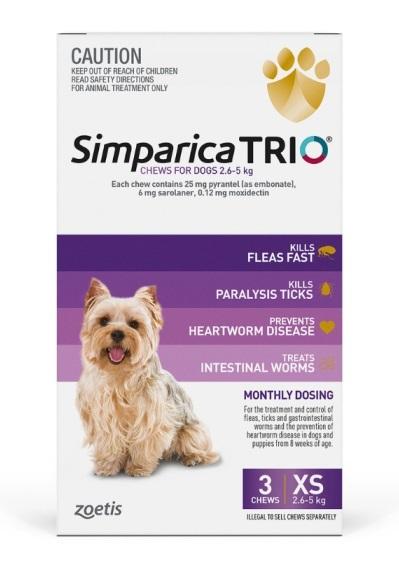Among canine preventive medications in the U.S., Simparica Trio for dogs is recognized for its broad parasitic coverage. Designed for monthly administration, it addresses both internal and external threats—from heartworm to fleas, ticks, and gastrointestinal worms. This article provides a thorough, factual overview of this combination treatment, its mechanisms, benefits, safety considerations, and guidance for responsible usage.
Regulatory Approval and Indications
In March 2020, the U.S. Food and Drug Administration officially approved Simparica Trio as a novel combination therapy containing sarolaner, moxidectin, and pyrantel. It is indicated for:
-
Prevention of heartworm disease (Dirofilaria immitis)
-
Treatment and prevention of flea infestations
-
Treatment and control of several tick species (e.g., Lone Star, Gulf Coast, American dog, black-legged, brown dog ticks)
-
Treatment and control of roundworms and hookworms
Approval applies to dogs and puppies aged eight weeks or older, weighing at least 2.8 pounds.
Active Ingredients and Modes of Action
Simparica Trio for dogs contains three distinct active ingredients, each targeting different parasites:
-
Sarolaner (an isoxazoline): Acts against fleas and ticks by disrupting their nervous systems, leading to paralysis and death U.S. Food and Drug Administration. It begins killing fleas within hours and maintains efficacy throughout the month.
-
Moxidectin (macrocyclic lactone): Effective against heartworm larvae—preventing disease progression by disrupting chloride channels in the parasite’s nervous system.
-
Pyrantel pamoate (tetrahydropyrimidine): Targets and paralyzes gastrointestinal worms (hookworms and roundworms), which are then expelled.
Administration and Dosage
Simparica Trio is administered orally once per month and may be given with or without food. Proper dosage is based on weight, with a broad range of tablet sizes available to ensure accuracy and compliance Daily Paws. If a dose is missed, veterinarians generally recommend administering it immediately and resuming regular monthly intervals.
Efficacy Against Parasites
Heartworm Prevention
Clinical trials report 100% effectiveness at preventing heartworm disease in controlled laboratory settings; field studies showed zero heartworm infections in treated dogs over 330 days.
Fleas
Studies showed 100% flea elimination within 8 hours of administration and ≥99.7% efficacy up to 35 days post-treatment. It also prevented flea reproduction throughout that period.
Ticks
Simparica Trio treats various U.S. tick species with efficacy above 90% for at least 28 days following treatment.
Intestinal Worms
It effectively controls and eliminates roundworms and hookworms in controlled studies and also prevents tapeworm infection by killing fleas that serve as vectors.
Safety Profile and Side Effects
Simparica Trio was generally well-tolerated in clinical trials, but adverse reactions were reported, including:
-
Vomiting (14.3%)
-
Diarrhea (13.2%)
-
Lethargy (8.5%)
-
Anorexia (5.1%)
-
Polyuria (3.7%)
-
Hyperactivity (2.2%)
-
Polydipsia (2.2%)
While no neurological side effects occurred in trials, animal regulators have issued caution of rare events—like tremors or seizures—linked to the isoxazoline class (sarolaner).
Usage Precautions
-
Heartworm Testing: Dogs must undergo a heartworm test before starting Simparica Trio, as the product does not treat adult infections.
-
Seizure Risks: Dogs with known neurological disorders require cautious assessment due to potential side effects.
-
Not Proven Safe in Pregnancy: Safety in breeding, pregnant, or lactating dogs has not been established.
-
Prescriptive Use Only: Available by prescription, ensuring veterinary oversight.
Veterinary Oversight and Monitoring
Veterinary involvement ensures proper eligibility (age and weight), diagnostic testing (like heartworm screening), and monitoring for side effects. Follow-up evaluations might include fecal testing for intestinal parasites or additional health checks.
Comparisons and Practical Considerations
Compared to using multiple individual preventatives, Simparica Trio simplifies the process with one chew. While this consolidation offers convenience and compliance benefits, veterinarians may recommend separate products for dogs with specific needs or sensitivities.
Cost and application convenience vary depending on the number of products otherwise required and the dog’s regional risk exposure—making Simparica Trio often a practical choice for broad coverage.
Community Feedback and Anecdotal Notes
Some dog owners have shared anecdotal observations of neurological changes—ranging from reactive behaviors to seizures—following administration. For example:
“Simparica Trio has caused reactivity in my dog... when it was stopped, behavior normalized.”
“My pup had seizures about 10 days after Simparica Trio…”.
While these accounts are not clinical evidence, they underscore the importance of careful observation and timely consultation with a veterinarian when concerns arise.
Conclusion
Simparica Trio for dogs offers a robust monthly solution to parasite prevention in the U.S., covering internal and external threats in a single, veterinarian-prescribed chewable. Its proven effectiveness against fleas, ticks, heartworm, and intestinal worms positions it as a convenient and comprehensive option.
However, responsible use includes veterinary consultation, heartworm testing, dosage compliance, and monitoring for rare adverse effects— particularly in dogs with neurological histories.
By aligning veterinary guidance with pet-specific needs, Simparica Trio may serve as a reliable foundation for parasite protection in many households.



